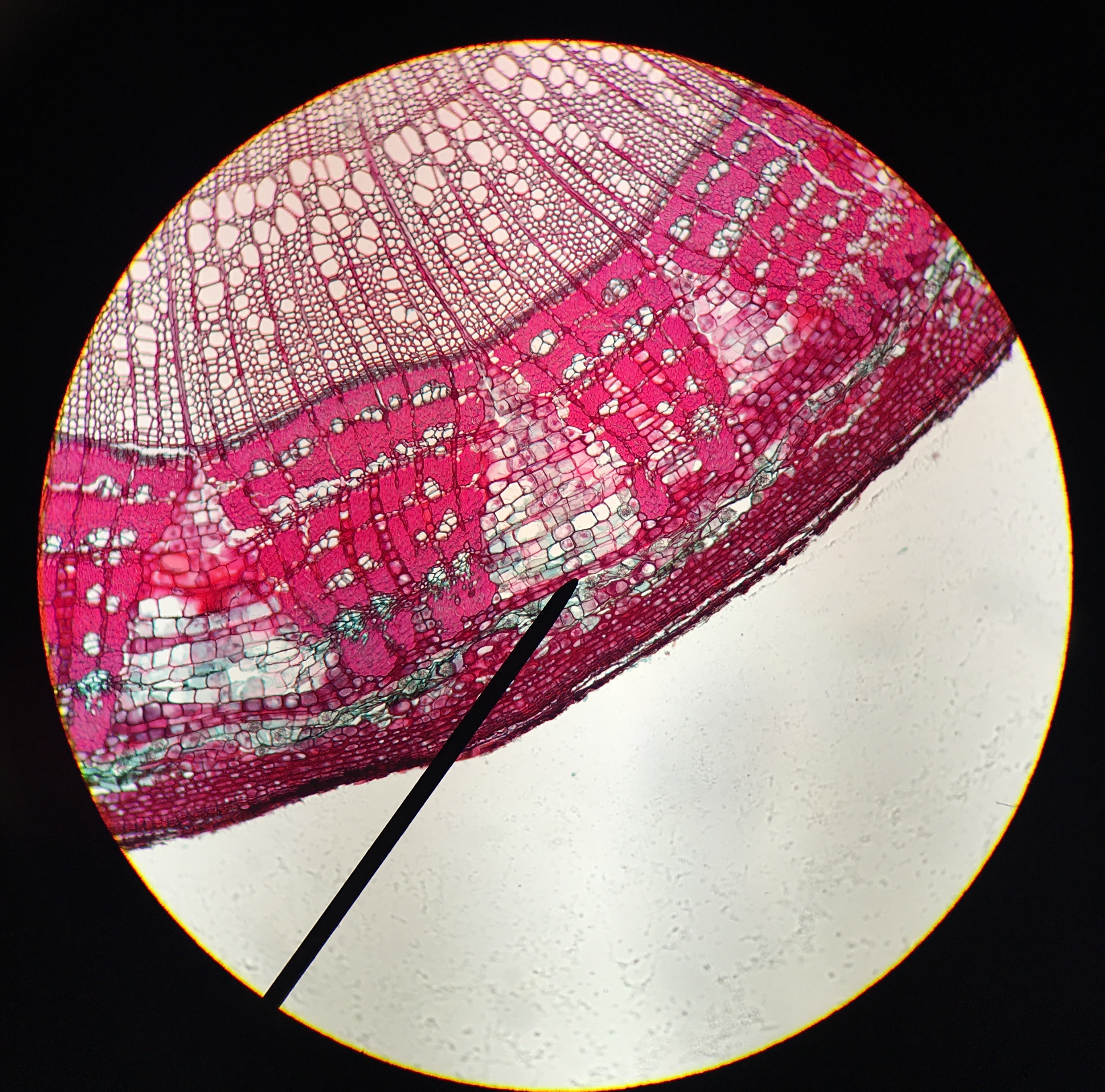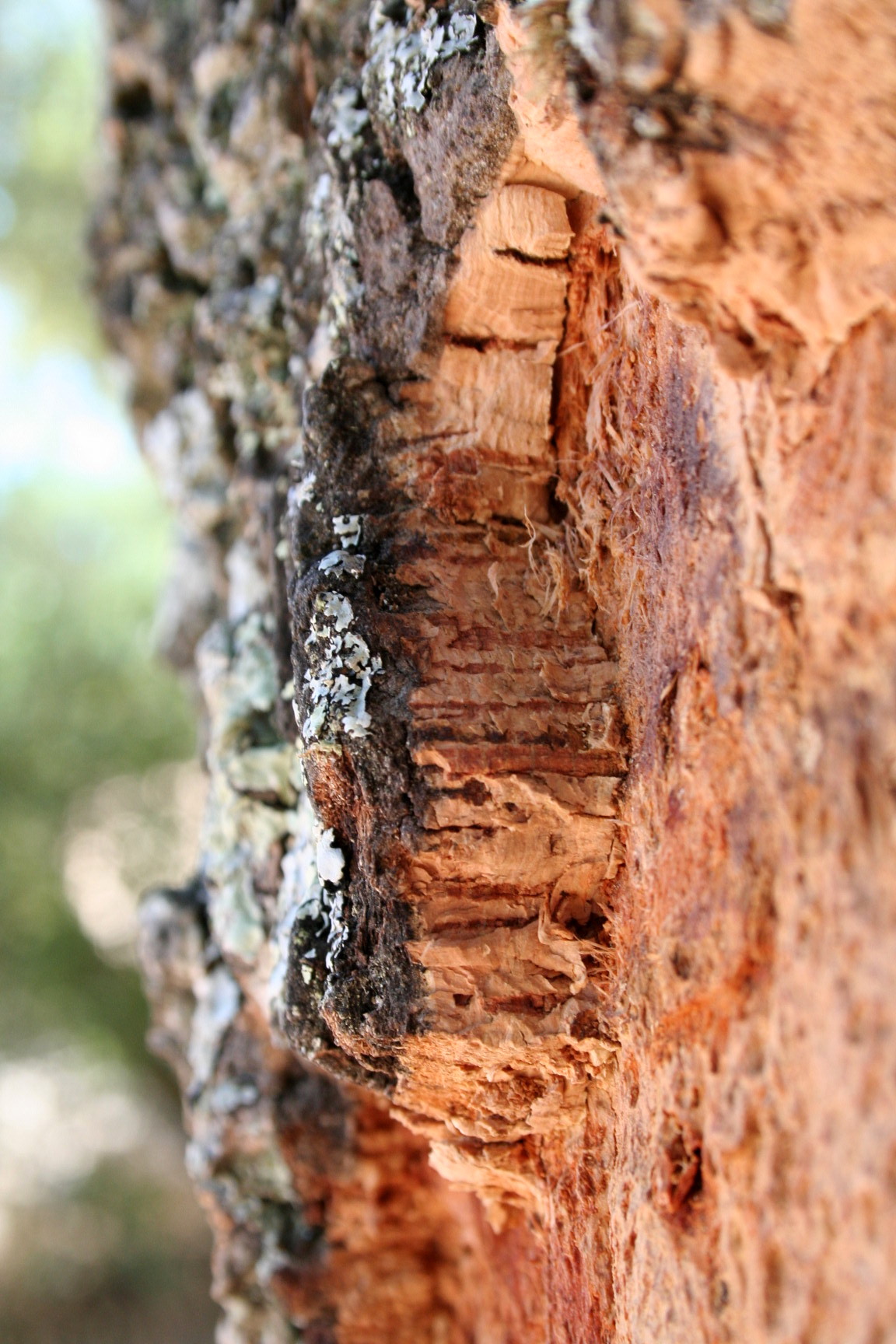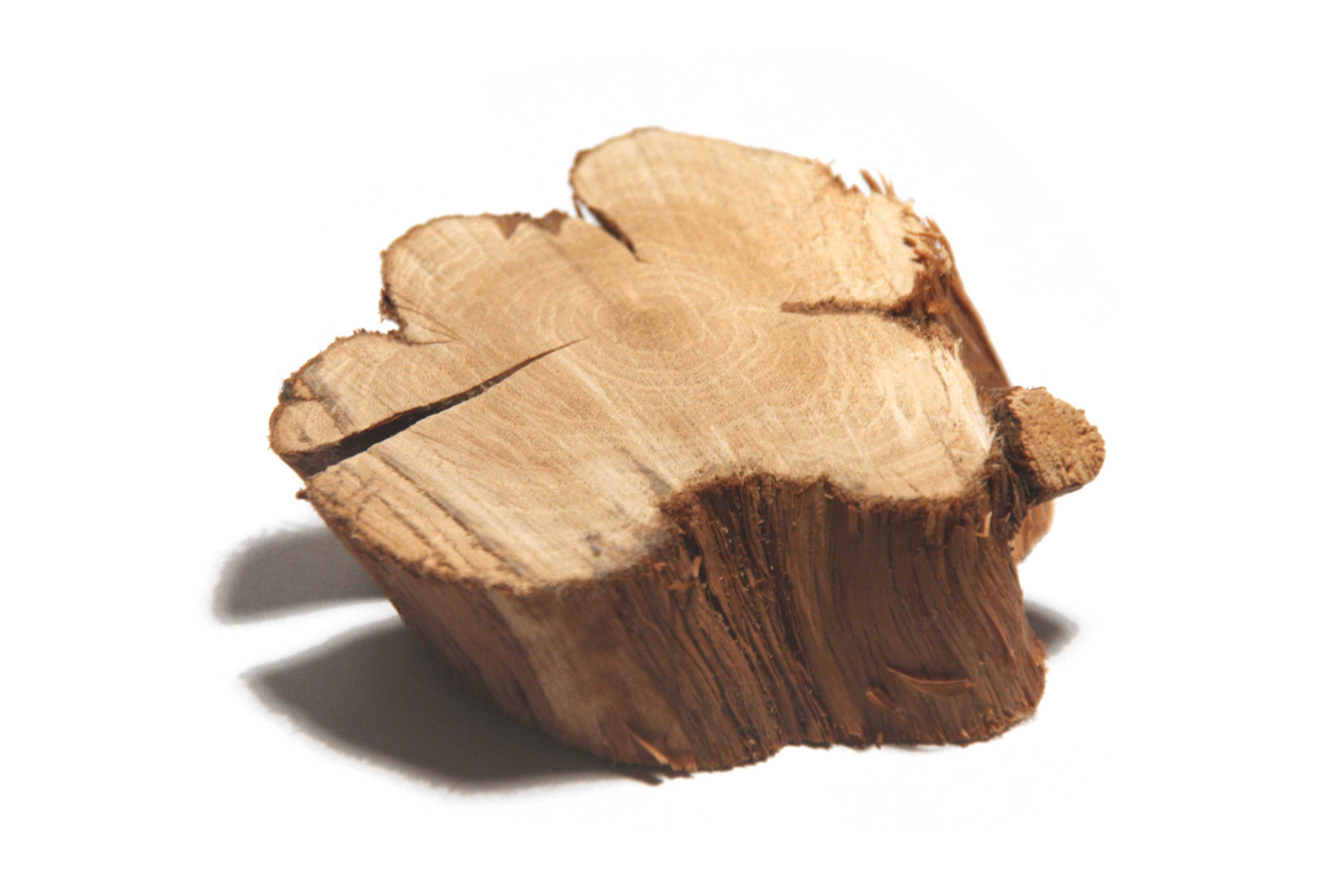|
Cambium
A cambium (plural cambia or cambiums), in plants, is a tissue layer that provides partially undifferentiated cells for plant growth. It is found in the area between xylem and phloem. A cambium can also be defined as a cellular plant tissue from which phloem, xylem, or cork grows by division, resulting (in woody plants) in secondary thickening. It forms parallel rows of cells, which result in secondary tissues. There are several distinct kinds of cambium found in plant stems and roots: * Cork cambium, a tissue found in many vascular plants as part of the periderm. * Unifacial cambium, which ultimately produces cells to the interior of its cylinder. * Vascular cambium, a lateral meristem in the vascular tissue of plants. Uses The cambium of many species of woody plants are edible; however, due to its vital role in the homeostasis and growth of woody plants, this may result in death of the plant if enough cambium is removed at once. The cambium can generally be eaten raw or cooke ... [...More Info...] [...Related Items...] OR: [Wikipedia] [Google] [Baidu] |
Phloem
Phloem (, ) is the living biological tissue, tissue in vascular plants that transports the soluble organic compounds made during photosynthesis and known as ''photosynthates'', in particular the sugar sucrose, to the rest of the plant. This transport process is called translocation. In trees, the phloem is the innermost layer of the bark (botany), bark, hence the name, derived from the Ancient Greek word (''phloiós''), meaning "bark". The term was introduced by Carl Nägeli in 1858. Structure Phloem tissue consists of conducting Cell (biology), cells, generally called sieve elements, Ground tissue#Parenchyma, parenchyma cells, including both specialized companion cells or albuminous cells and unspecialized cells and supportive cells, such as fibres and sclereids. Conducting cells (sieve elements) Sieve elements are the type of cell that are responsible for transporting sugars throughout the plant. At maturity they lack a Cell nucleus, nucleus and have very few organelles, ... [...More Info...] [...Related Items...] OR: [Wikipedia] [Google] [Baidu] |
Vascular Cambium
The vascular cambium is the main growth tissue in the stems and roots of many plants, specifically in dicots such as buttercups and oak trees, gymnosperms such as pine trees, as well as in certain other vascular plants. It produces secondary xylem inwards, towards the pith, and secondary phloem outwards, towards the bark. In herbaceous plants, it occurs in the vascular bundles which are often arranged like beads on a necklace forming an interrupted ring inside the stem. In woody plants, it forms a cylinder of unspecialized meristem cells, as a continuous ring from which the new tissues are grown. Unlike the xylem and phloem, it does not transport water, minerals or food through the plant. Other names for the vascular cambium are the main cambium, wood cambium, or bifacial cambium. Occurrence Vascular cambia are found in all seed plants except for five angiosperm lineages which have independently lost it; Nymphaeales, Ceratophyllum, Nelumbo, Podostemaceae, and monocots. A few ... [...More Info...] [...Related Items...] OR: [Wikipedia] [Google] [Baidu] |
Xylem
Xylem is one of the two types of transport tissue in vascular plants, the other being phloem. The basic function of xylem is to transport water from roots to stems and leaves, but it also transports nutrients. The word ''xylem'' is derived from the Ancient Greek word (''xylon''), meaning "wood"; the best-known xylem tissue is wood, though it is found throughout a plant. The term was introduced by Carl Nägeli in 1858. Structure The most distinctive xylem cells are the long tracheary elements that transport water. Tracheids and vessel elements are distinguished by their shape; vessel elements are shorter, and are connected together into long tubes that are called ''vessels''. Xylem also contains two other type of cells: parenchyma and fibers. Xylem can be found: * in vascular bundles, present in non-woody plants and non-woody parts of woody plants * in secondary xylem, laid down by a meristem called the vascular cambium in woody plants * as part of a stelar arrangement n ... [...More Info...] [...Related Items...] OR: [Wikipedia] [Google] [Baidu] |
Cork Cambium 1
Cork or CORK may refer to: Materials * Cork (material), an impermeable buoyant plant product ** Cork (plug), a cylindrical or conical object used to seal a container ***Wine cork Places Ireland * Cork (city) ** Metropolitan Cork, also known as Greater Cork ** Cork Airport * County Cork Historical parliamentary constituencies * Cork City (Parliament of Ireland constituency) * Cork County (Parliament of Ireland constituency) * Cork City (UK Parliament constituency) * Cork County (UK Parliament constituency) United States * Cork, Georgia * Cork, Kentucky Organisations * Cork GAA, responsible for Gaelic games in County Cork * Ye Antient Order of Noble Corks, a masonic order, also known as "The Cork" * Cork City F.C., a football club * Cork City W.F.C., a women's football club Other uses * A particular kind of trick in snowboarding and skiing. See List of snowboard tricks. * Cork (surname) * Cork City (barony) * Cork encoding, a digital data format * Cork taint, a wine fault * Ca ... [...More Info...] [...Related Items...] OR: [Wikipedia] [Google] [Baidu] |
Plant Cell
Plant cells are the cells present in green plants, photosynthetic eukaryotes of the kingdom Plantae. Their distinctive features include primary cell walls containing cellulose, hemicelluloses and pectin, the presence of plastids with the capability to perform photosynthesis and store starch, a large vacuole that regulates turgor pressure, the absence of flagella or centrioles, except in the gametes, and a unique method of cell division involving the formation of a cell plate or phragmoplast that separates the new daughter cells. Characteristics of plant cells * Plant cells have cell walls, constructed outside the cell membrane and composed of cellulose, hemicelluloses, and pectin. Their composition contrasts with the cell walls of fungi, which are made of chitin, of bacteria, which are made of peptidoglycan and of archaea, which are made of pseudopeptidoglycan. In many cases lignin or suberin are secreted by the protoplast as secondary wall layers inside the primary cell wall. ... [...More Info...] [...Related Items...] OR: [Wikipedia] [Google] [Baidu] |
Cork Cambium
Cork cambium (pl. cambia or cambiums) is a tissue found in many vascular plants as a part of the epidermis. It is one of the many layers of bark, between the cork and primary phloem. The cork cambium is a lateral meristem and is responsible for secondary growth that replaces the epidermis in roots and stems. It is found in woody and many herbaceous dicots, gymnosperms and some monocots (monocots usually lack secondary growth). It is one of the plant's meristems – the series of tissues consisting of embryonic disk (incompletely differentiated) cells from which the plant grows. The function of cork cambium is to produce the cork, a tough protective material.Junikka, L. (1994) "Macroscopic bark terminology". ''IAWA Journal'' 15(1): 3–45Trockenbrodt, M. (1990) "Survey and discussion of the terminology used in bark anatomy". ''IAWA Bulletin, New Series'' 11: 141–166 Synonyms for cork cambium are bark cambium, pericambium and phellogen. Phellogen is defined as the meristemati ... [...More Info...] [...Related Items...] OR: [Wikipedia] [Google] [Baidu] |
Periderm
Bark is the outermost layers of stems and roots of woody plants. Plants with bark include trees, woody vines, and shrubs. Bark refers to all the tissues outside the vascular cambium and is a nontechnical term. It overlays the wood and consists of the inner bark and the outer bark. The inner bark, which in older stems is living tissue, includes the innermost layer of the periderm. The outer bark on older stems includes the dead tissue on the surface of the stems, along with parts of the outermost periderm and all the tissues on the outer side of the periderm. The outer bark on trees which lies external to the living periderm is also called the rhytidome. Products derived from bark include bark shingle siding and wall coverings, spices and other flavorings, tanbark for tannin, resin, latex, medicines, poisons, various hallucinogenic chemicals and cork. Bark has been used to make cloth, canoes, and ropes and used as a surface for paintings and map making. A number of plants are ... [...More Info...] [...Related Items...] OR: [Wikipedia] [Google] [Baidu] |
Unifacial Cambium
The unifacial cambium (pl. cambia or cambiums) produces cells to the interior of its cylinder. These cells differentiate into xylem tissue. Unlike the more common bifacial cambium found in later woody plants, the unifacial cambium does not produce phloem to its exterior. Also in contrast to the bifacial cambium, the unifacial cambium is unable to expand its circumference with anticlinal cell division. Cell elongation provides a limited amount of expansion. Unifacial cambium plant morphology and life cycles The unifacial cambium allowed plants to grow as tall as 50 metres. Lacking secondary phloem, unifacial cambium plants developed alternative strategies to long range nutrient transport. For example, the stems of lycophyte The lycophytes, when broadly circumscribed, are a vascular plant (tracheophyte) subgroup of the kingdom Plantae. They are sometimes placed in a division Lycopodiophyta or Lycophyta or in a subdivision Lycopodiophytina. They are one of the oldest ... tr ... [...More Info...] [...Related Items...] OR: [Wikipedia] [Google] [Baidu] |
Meristem
The meristem is a type of tissue found in plants. It consists of undifferentiated cells (meristematic cells) capable of cell division. Cells in the meristem can develop into all the other tissues and organs that occur in plants. These cells continue to divide until a time when they get differentiated and then lose the ability to divide. Differentiated plant cells generally cannot divide or produce cells of a different type. Meristematic cells are undifferentiated or incompletely differentiated. They are totipotent and capable of continued cell division. Division of meristematic cells provides new cells for expansion and differentiation of tissues and the initiation of new organs, providing the basic structure of the plant body. The cells are small, with no or small vacuoles and protoplasm fills the cell completely. The plastids (chloroplasts or chromoplasts), are undifferentiated, but are present in rudimentary form (proplastids). Meristematic cells are packed closely together wi ... [...More Info...] [...Related Items...] OR: [Wikipedia] [Google] [Baidu] |
Woody Plant
A woody plant is a plant that produces wood as its structural tissue and thus has a hard stem. In cold climates, woody plants further survive winter or dry season above ground, as opposite to herbaceous plants that die back to the ground until spring. Characteristics Woody plants are usually either trees, shrubs, or lianas. These are usually perennial plants whose stems and larger roots are reinforced with wood produced from secondary xylem. The main stem, larger branches, and roots of these plants are usually covered by a layer of bark. Wood is a structural tissue that allows woody plants to grow from above ground stems year after year, thus making some woody plants the largest and tallest terrestrial plants. Woody plants, like herbaceous perennials, typically have a dormant period of the year when growth does not take place, in colder climates due to freezing temperatures and lack of daylight during the winter months, in subtropical and tropical climates due to the dry sea ... [...More Info...] [...Related Items...] OR: [Wikipedia] [Google] [Baidu] |
Homeostasis
In biology, homeostasis (British English, British also homoeostasis) Help:IPA/English, (/hɒmɪə(ʊ)ˈsteɪsɪs/) is the state of steady internal, physics, physical, and chemistry, chemical conditions maintained by organism, living systems. This is the condition of optimal functioning for the organism and includes many variables, such as body temperature and fluid balance, being kept within certain pre-set limits (homeostatic range). Other variables include the pH of extracellular fluid, the concentrations of sodium, potassium and calcium ions, as well as that of the blood sugar level, and these need to be regulated despite changes in the environment, diet, or level of activity. Each of these variables is controlled by one or more regulators or homeostatic mechanisms, which together maintain life. Homeostasis is brought about by a natural resistance to change when already in the optimal conditions, and equilibrium is maintained by many regulatory mechanisms: it is thought to be ... [...More Info...] [...Related Items...] OR: [Wikipedia] [Google] [Baidu] |
Flour
Flour is a powder made by grinding raw grains, roots, beans, nuts, or seeds. Flours are used to make many different foods. Cereal flour, particularly wheat flour, is the main ingredient of bread, which is a staple food for many cultures. Corn flour has been important in Mesoamerican cuisine since ancient times and remains a staple in the Americas. Rye flour is a constituent of bread in central and northern Europe. Cereal flour consists either of the endosperm, germ, and bran together (whole-grain flour) or of the endosperm alone (refined flour). ''Meal'' is either differentiable from flour as having slightly coarser particle size (degree of comminution) or is synonymous with flour; the word is used both ways. For example, the word '' cornmeal'' often connotes a grittier texture whereas corn flour connotes fine powder, although there is no codified dividing line. The CDC has cautioned not to eat raw flour doughs or batters. Raw flour can contain bacteria like '' E. col ... [...More Info...] [...Related Items...] OR: [Wikipedia] [Google] [Baidu] |







